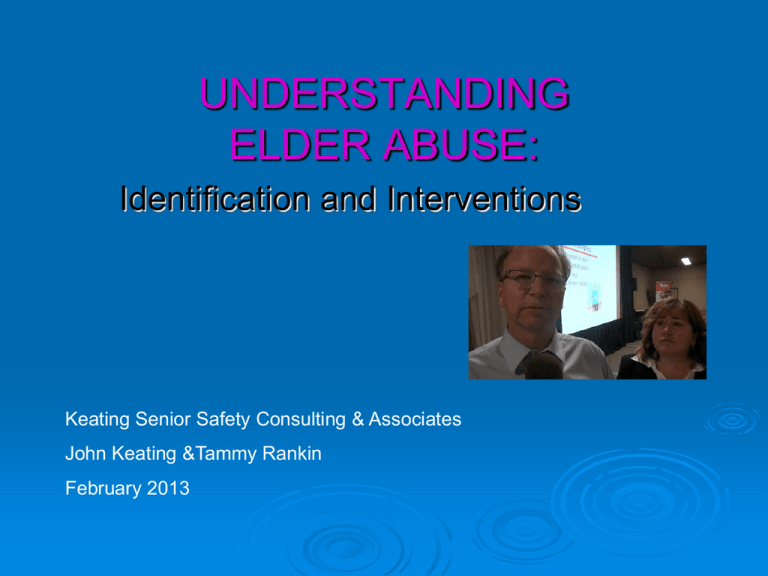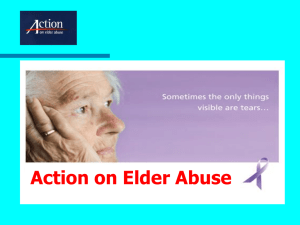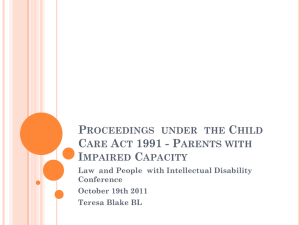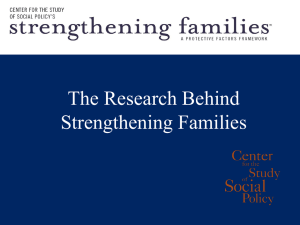
UNDERSTANDING
ELDER ABUSE:
Identification and Interventions
Keating Senior Safety Consulting & Associates
John Keating &Tammy Rankin
February 2013
Section 1
Definitions, Indicators,
Case examples
Definition of Elder Abuse and Neglect
Abuse is any act or failure to act, within a
relationship where there is an expectation of
trust, that jeopardizes the health or well-being of
an older person.
Neglect is any inaction, either intended or
unintended, within a relationship where there is
an expectation of trust, that causes harm to an
older person.
Criminal Code
Intimidation
(Sec. 423 c.c)
Uttering Threats (Sec. 264.1 c.c)
Harassing Telephone Calls (Sec. 372.3)
Physical Abuse
Occurs when someone uses violence or rough handling
causing injury, pain, or discomfort.
Withholding medications or overmedication for
inappropriate purposes
Signs:
Repeated 'accidents‘ or Injury for which the reason given
does not make sense
Unexplained injuries such as bruises, burns, cuts,
swelling, grip marks or rope marks
Examples:
Rough handling
Confining someone to a bed, chair or room
Slapping, hitting, pushing, punching or kicking
Criminal Code
Assault
(Sec. 265 c.c)
Assault with a weapon (Sec. 267 c.c)
Aggravated Assault (Sec. 268 c.c)
Forcible Confinement (Sec. 279 c.c)
Murder (Sec. 229 c.c)
Manslaughter (Sec. 234 c.c)
Material/ Financial Abuse
Misuse of a senior's money, property, or possessions through theft,
scam or fraud.
Signs:
• Things/money go missing
• Unusual banking activities
• Older person has signed 'papers‘ without full understanding or
under unusual conditions
lack of money for needed items
Senior is homeless
Examples:
Fraud
Forgery and Theft
Misuse by a person given the power to act or sign for the senior
Obtain money/things by threat
Criminal Code - Financial
Theft
(Sec 322 c.c)
Theft by holding Power of Attorney (Sec.
331 c.c)
Stopping Mail with Intent (Sec. 345 c.c)
Extortion (Sec. 346 c.c)
Forgery (Sec. 365 c.c)
Fraud (Sec. 380 c.c)
Emotional/ Psychological/ Verbal
Abuse
Any word or act that decreases an older adult's sense of self worth and
dignity
Signs:
Shows fear (around the abuser)
May be unsettled and upset
Isolated
Puts herself/himself down
Has feelings of guilt and blame
Shows signs of depression
Examples:
Jokes about the older person
Frightens the senior on purpose – threats of institutionalization
Treats the senior like a child
Attacks senior's pride/dignity
Threatens or takes away:
love and affection
emotional support
Criminal Code
Intimidation
(Sec. 423 c.c)
Uttering Threats (Sec. 264.1 c.c)
Harassing Telephone Calls (Sec. 372.3)
Neglect – Active, Passive, Self
A failure to meet the needs of an older adult who cannot meet these
needs on their own.
Active Neglect is refusing to provide for the basic needs and/or
care of an older adult.
Passive Neglect is the failure to provide care to a senior because of
a lack of experience, information or ability.
Self Neglect occurs when a senior does not care for himself/ herself
due to:
• His/her choice
• Poor Health (mind or body)
• Loss of friends/relatives
• Depression
Indicators of Neglect
Signs:
Dirty clothing, unclean hair, or body odor
Poorly kept living space
Lack of food
Dehydration or malnutrition
'Invisible' Homelessness such as 'sleeping on a couch
or in a garage'
Examples:
Neglect is a failure of a caregiver to:
Meet basic needs like food, water, suitable clothing or
safe and clean shelter
Attend to personal care like washing & dressing
Provide social contact
Criminal Code
Criminal
Negligence Causing Bodily Harm
or Death (Sec. 220-21 c.c)
Fail to Provide Necessities (Sec. 215 c.c)
Sexual Abuse
Unwanted touching of or sexual activity with a senior
without their consent or full knowledge. Sexual abuse of
older persons is often ignored because seniors are not
thought of as being sexual.
Signs:
Physical Signs: Pain, swelling or bleeding in the genital
or anal area
Other bruising, grip marks, or wounds that point to
sexual assault
Emotional Signs: Fear of being near or alone with a
certain person
Examples:
Sexual abuse can range from unwanted kissing or
fondling to forced sexual acts
Unwanted verbal (jokes, rude remarks) or visual acts
(showing private parts, photographs)
Criminal Code
Sexual
Assault (Sec. 271 c.c)
Sexual Assault with a weapon, threats to a
third party or causing bodily harm (Sec.
272 c.c)
Aggravated Sexual Assault (Sec. 273 c.c)
Abuse in Care Settings
Becoming
more transparent
Historically
not talked about
Paternalistic
approach to elder case
QUIZ TIME
TAMMY DO NOT CLICK!
Who is Committing the
Abuse?
SON
1% 1%
2%
DAUGHTER
24%
HUSBAND
2%
4%
24%
5%
WIFE
BROTHER
SISTER
16%
21%
NIECE
NEPHEW
GRANDCHILD
UNRELATED
CAREGIVER
Why – Historic Approaches Haven’t
worked?
No one ‘owned’ the
issue – lack of
consistency
No seamless transition
between services and
resources (referral
fatigue)
Victim is in isolation
surrounded by help
rather than connected
Police
Housing
(LTC/ RH)
Courts
Victim of
Elder Abuse
Victim
Witness
Assistance
Community
Services
Health
Services
Why the challenges?
Professional terminology and acronyms
Ex. ‘arrears’ vs. ‘theft’, ‘responsive behaviour’ vs.
assault
Different training and different context for
understanding situation – cases of neglect (not
normal aging)
Lack of information sharing and transparency
Conspiracy of silence – historical context of
abuse in health and social service sector (ex.
Posey jackets)
Lack of understanding of how/when we should
work together
Interventions - What does that
look like?
So what to do when you suspect
abuse?
Starting
the conversation with senior
Advocacy starts with what the client
wants not what you think he/she should
want
Least intrusive most effective
Ethics decision making tool – NICE
Balance the pros and cons of intervention
Leap of faith
When Elder Abuse is Identified
Documentation
Referral
Support
6 Tips to good interviewing
Preparation
Build
Rapport - Norm
Omissions – failing to mention important
things
Needless interruption is a common error
Listen with ears (and eyes) non verbal
comm.
No one thing i.e.: crossed arms – must be
constellation of things
What does the Interviewer Do?
Ask
questions and obtain information
Listen to interviewee
Observe body language of interviewee
Approach to doing interview
Plan the interview
Arrange the interview
Meeting the subject – ask questions he
knows to establish the norm
State objective
Start with open ended questions
Review – then come back with close ended
questions
Conclude the interview
Write out Questions
Make
sure you write your questions open
ended not closed
EX: Did you visit Mrs Jones in her room
yesterday? Closed
Better question EX: Tell me when you last
visited Mrs Jones in her room?
(if you already know the answer, ask
question as if you don’t know)
Don’t use compound questions
Ex:
Can you tell me what time you started
work and what door you used to enter the
building and did you see anyone when you
came in the door?
Better way is to keep each question to a
single issue ex: what time did you start
work? What door did you enter?
Valuable first 5 minutes
Non
interview questions
Open ended conversation
Find common bond interest
Be genuine
Listen and repeat things they say to show
your interest
Lets you establish the NORM
Types of Statements
Open
Pure Version: Let them write in out
Then do Q and Q’s
You said “……” Can you tell me more?
Or, you write it out as they tell you and do
your interview and take notes
Tips for note-taking;
number your pages
never
leave empty lines or blank spaces
never
duplicate or photo-copy your notes
use
ink pen, any errors – straight line only
Photos
– no digital camera
31
What is Capacity
Can
fluctuate
Always take direction from senior when
possible – benevolent paternalism
Testing understanding facts and
consequences
Can be capable in one area but incapable
in another
Respect Autonomy Whenever
Possible
What
is autonomy?
Older adults who are capable have rights
and we need to be sensitive to that
Older adults who are deemed incapable
have rights.
Police can’t do anything without
cooperation of victim/ witnesses
When first building rapport
People
decide if they like or don’t like
someone within the first 90 seconds
Building rapport helps to establish a
trusting relationship
You want the senior to feel safe talking to
you
Getting a senior to tell their story is the first
step to getting help
Ethical Considerations
When
to do nothing vs. ethical
requirements (abuse as defined by who –
my son Jacob)
Ethical decision making model – N.I.C.E
Considering all aspects of intervention
Respect for choice
Understand the relationship of the victim
and abuser (is it really ABUSE)
Cultural Context
Know
the cultural lens the relationship
exists in
Do the research
Be sensitive to the culture and remember
the senior defines what is a normal
relationship for him/her
Investigating
alleged elder abuse can be
physically, emotionally, psychologically,
and spiritually upsetting and stressful for
many reasons
Self
care is essential
37
Compassion Fatigue
Emotional
vs. Physical Fatigue
Caring too much
Emotional blanket – protecting yourself
Vicarious Victimization
Guilt
Respect and Dignity
How we think is reflected in how
we act and respond
Aren’t our seniors worth more?
So…what’s next
“Change will not come if we wait for some
other person or some other time. We are
the ones we’ve been waiting for. We are
the change that we seek.”.
Barack Obama
A Call To Action!








